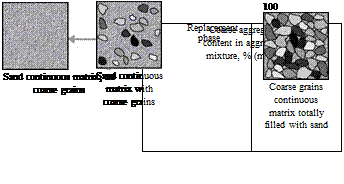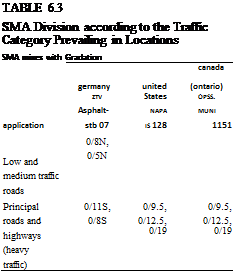DESIGNING AN AGGREGATE MIX BY. APPLYING GRADATION LIMITS
The application of gradation limits has become the most commonly used method for designing SMA mix composition. This method involves gradation analyses of all the constituent aggregates, including the filler, followed by balancing the proportions of all the aggregates in such a way that the ultimate gradation curve is situated between the adopted gradation limits. Used alone, it is a very simple method. Unfortunately it is characterized by some drawbacks that may result in a poor SMA mix design.
The advantages of the method of gradation limits include the following:
• The method is simple to use and quick to produce results. After the gradation analyses of the constituent materials are carried out, the proportions of the mix constituents can be quickly calculated simply by using computer software. It is also easy to relocate the gradation curve by manipulating the percentages of the constituents. However, for the very experienced engineer there are better ways to analyze and predict the behavior of the mix.
The disadvantages of this method are as follows:
• The position of a gradation curve inside gradation limits does not absolutely secure an appropriate design of an aggregate mix. For example, the gradation curve graph itself is not enough to predict and secure both a suitable aggregate skeleton and the impact of flat and elongated particles.
• Some major or minor errors occur in volume relations of constituent materials when using only mass units to show the gradation. If the method does not stipulate this, differences in densities of constituents are not taken into consideration. Significant differences in aggregate densities produce substantial differences in the volume relations of a mix. This is not apparent on a gradation curve if it shows the weight distribution retained on sieves, though it can obviously be solved by presenting the gradation in terms of volume units.
• It is presupposed that gradation limits illustrate the area of an appropriate gradation. However, as practice proves, the limits of a suitable gradation should also be periodically verified and mistakes corrected.
In summary, it is safe to say that relying only on the method of gradation limits leads to designing SMA with a low degree of reliability of performance. In Chapter 7, some SMA design methods are discussed, with the application of some concepts extending beyond the use of gradation limits.








